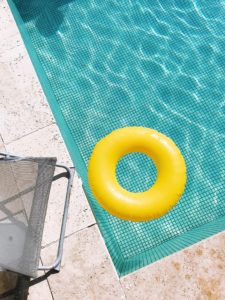ATLANTA, GA – July 17, 2023 – The Centers for Disease Control and Prevention (CDC) reports that drowning is the leading cause of death for children in the United States. This is because more than one-half of Americans lack basic swimming skills and millions do not have access to safe places to swim according to a Red Cross estimate. Drowning is the most frequent cause of death for children ages 1-4. For children ages 5-14, it is the second most frequent cause of accidental injury death after motor vehicle accidents. Although drowning is a preventable public health issue, the United States is without a coordinated plan to reduce the number of fatal and nonfatal drownings and improve water safety. We know that this has been a very hot summer especially in southern states like North Carolina. Many young people look for relief from the heat by going to the closest available pool, river or lake in order to keep cool. What can be done to keep our children cool and safe?
Drowning can occur due to breathing impairment encountered from being in water or under the surface of the water. Some drownings are fatal and some are not. Nonfatal drowning occurs when the person survives the incident. Severe problems can arise from nonfatal drowning including brain damage or permanent disability.
For every person under age 18 who dies from drowning, there are 7 who are seen in the emergency department for nonfatal drowning incidents. Almost 4 of 10 nonfatal drownings are either hospitalized or must be transferred to another hospital for care. Although drowning deaths have decreased by 33% in the past 30 years, there are still 4 thousand drowning deaths in the U.S. annually. The estimated annual cost is $53 billion according to the CDC. One in 4 drowning deaths are in children.
Some children are at a higher risk of drowning according to their parent’s ability to swim, their age, their economic resources, and their racial group. Most drownings in children ages 1-4 occur in swimming pools. A drowning can happen when the child is without adult supervision and not supposed to be in the pool. Drowning death rates are much higher for Black children than White children, ages 5-14. A child of a parent who has never learned how to swim learns to swim only 13% of the time. A child in a multifamily home is more likely to have a drowning fatality than a child from a single-family home.
Drowning deaths vary by location. Most drownings in infants under 1 year occur in bathtubs. Most drownings among children ages 1-4 occur in private swimming pools. Drowning among children 5-14 occur most frequently in natural bodies of water and 2nd most often in pools. Most drownings in adolescents 15 years and older occur in natural bodies of water like lakes, rivers and the ocean.
According to the CDC, there are more than 10 million private swimming pools in the U.S. and only 309 thousand public ones. Americans have very few places to learn how to swim unless they can afford swim lessons at private pools. Learning how to swim and swimming safely has been made worse in recent years by a national shortage of life guards. Therefore, the U.S. National Water Safety Action Plan was created this year to address the need that “everyone is safe in the water, on, and around the water.” The Plan is the result of a collaboration between governmental and non-government organizations whose goal is to reduce drowning in the U.S.
According to a recent New York Times editorial by Mara Gay, “In America today, swimming is a luxury, not a public good.”
Factors that contribute to children drownings include:
- Being unable to swim or a weak swimmer
- Having inadequate fencing around home pools
- Poor supervision
Important interventions to reduce incidents of drowning in children are:
- Swimming lessons and water safety education need to be affordable and accessible to all
- Public pools need to be built
- Designated swimming areas at lakes and rivers in rural areas and swimming deserts need to be created
- 4-sided fences should be required around home pools
- More life guards need to be hired at all public swimming pools and at popular swimming areas
Listen to the full report below:
Contact: Dr. Dick Needleman, Health reporter, 103.3 AshevilleFM, [email protected]
More Posts for Show: Asheville FM News Hour
